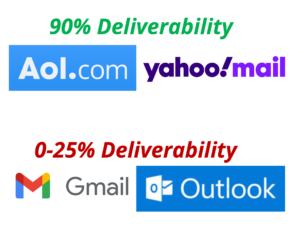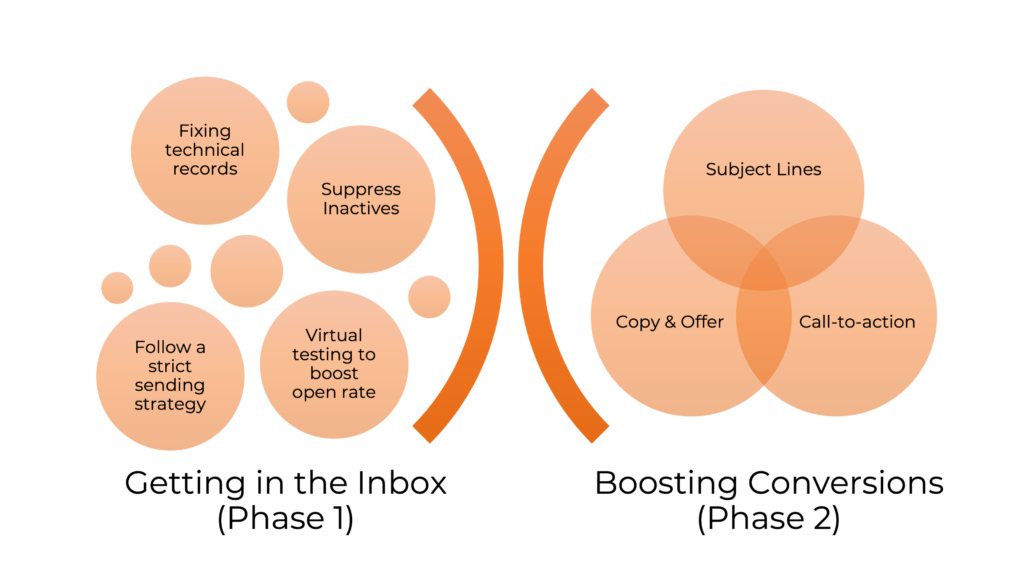Home » Email Marketing Consultancy Services » Case Studies »

How Printerpix achieved 100% email deliverability in Gmail
The problem: 0% to 14% email deliverability in 2 key ISPs

Printerpix is an eCommerce company with operations in both the UK and the United States. The U.S. domain began the year with inbox placement well over 90% for both Yahoo! Mail and AOL, but only 30% in Gmail and 20% in Outlook/Hotmail. They had an email deliverability problem.
By the time my company was brought on in mid-year, U.S. inbox placement had fallen to 0% at Gmail and 14% in Outlook/Hotmail. It remained high at Yahoo! Mail and AOL. UK inbox placement was in a similar position – high with Yahoo! and AOL but zero for Gmail and 25% for Outlook/Hotmail.
We needed to help Printerpix drastically improve their email deliverability, so it could reach more customers and, ultimately, earn more revenue. But, to make that happen, we needed to find out why the company was getting shut out from the two key ISPs that make up the majority of their database in both the UK and US.
To do this, we took a holistic approach, beginning with strategy, infrastructure, design, and copy.
Contributing factors: Technical issues, high inactivity: Using eDataSource, the panel data showed us there was a solid sample size of panellists. This enabled us to be confident in the results and confirmed our fears that deliverability was bad. Viewing two years’ worth of panel data allowed us to formulate a hypothesis about what was causing the problem and then jump straight in to tackle the issue without having to wait to send seeded campaigns. Our audit turned up several technical issues, such as improperly configured SPF and DMARC, a high spam complaint rate, no “Abuse@” and “postmaster@” addresses and a database with about 60% inactive addresses.
Our Printerpix plan had three phases:
- Setting up authentication, cleaning the list, implementing the ‘halo’ sending strategy
- A/B testing to increase conversions
- Building out the rest of the email programme

Phase 1: Setting up authentication, cleaning the list, implementing the ‘halo’ sending strategy
We launched a five-step reconstruction plan:
- Fixing technical records
- Suppressing inactives
- Follow a strict sending strategy
- Virtual testing to boost the open rate
- Implementing a new template
To carry it out, we began by correcting the back-end problems first, fixing the SPF concerns and setting up a DMARC protocol. Then, we temporarily stopped sending to the inactive addresses. This was a temporary move to give us some breathing room while we worked on improving our client’s sender reputation.
As we stopped mailing the inactives, we doubled the number of emails sent to the actives so that we could maintain a consistent sending routine. This is a signal that ISPs like to see, which helps with sender reputation.
Aside from suppressing inactives, we also used FreshAddress to clean our client’s database. As a final step, we used what I call the “halo” sending strategy, in which we segmented the database into four groups based on recency of opens, from most recently active to least recently active. Then, we sent emails in the order of activity, beginning with the most recently active. The art to this is to begin sending the next segment as soon as the first segment has finished sending, so it’s a continuous send of all segments.
Tactical manoeuvre:
Focus on open rates, redesigned email template: Marketers often debate the value of the open rate as a measure of engagement and email success and rightly so. However, our testing period demonstrates a situation when the open rate is the right metric for optimisation and measuring success.
Why the open rate and not clicks or conversions? Because ISPs use the open rate to measure engagement and base decisions on deliverability.
Go for the open rate:
Although we knew we might take a hit on revenue in the short term, as optimising for open rates doesn’t always result in an increase in conversions, our first goal was to increase our client’s inbox placement. In the long term, this would help our client earn more revenue from email.
So, we focused on discovering which subject lines would persuade more subscribers to open Printerpix’s emails.
To help us in this quest, we used Touchstone, a virtual subject-line testing tool, to virtually test using our historic data, 10 subject lines for each one of our client’s products. The open rate was the success metric.
We chose virtual testing over regular testing because our deliverability was so bad, regular testing would not have been as effective. Plus, we didn’t want to send anyone a losing subject line – we needed all the positive help we could get.
New look for email design:
We also designed a new master template, swapping out the previous image-based design for one that was HTML-based. It included bullet-proof call-toactions and stylised ALT text, providing an easy-to-read email for subscribers who didn’t display images.
Phase 2: A/B testing to increase conversions
As soon as Printerpix’s deliverability at Gmail and Outlook/Hotmail began to rise, we focused on boosting conversion.
Once we hit the 90% deliverability mark, we began using A/B split testing on subject lines, call-to-action, and copy. This time, the click rate became our success metric.
We ran tests to optimise the emails using a single hypothesis across multiple campaigns. We saw an uplift on our variants over the control, achieving anywhere between 6% & 15% uplift with 95% & 99% statistical significance.
Results:
Higher revenue, better deliverability: Within 10 weeks after work began, the Printerpix UK domain achieved 100% inbox placement across the board at key email services (Gmail, Outlook/Hotmail, Yahoo and AOL). Shortly after, the US domain hit 96% inbox placement at both Gmail and Outlook/Hotmail and 100% at AOL and Yahoo! Mail.
This higher deliverability helped Printerpix realise an 8X increase in revenue. This illustrates the direct connection between improved deliverability and revenue.
Gearing up for Printerpix’s peak season – Black Friday/Cyber Monday and Christmas As soon as we hit deliverability in the high 90s, we began to add the inactives onto our campaigns following a detailed ramping up strategy. This ensured we warmed up the inactives with Printerpix’s presence as well as building up the volume in readiness for the peak period.
By Black Friday, we’d not only been back in touch with all the inactives but had increased the volumes. This let us send high volumes daily through the peak period without sacrificing deliverability.
The end result? A YoY increase of 240% revenue for the UK and 297% increase in revenue for the US during the peak period months of November and December.
Phase 3: Building out the rest of the email programme
Having shored up that foundation, we moved on three areas to help our client build ongoing
engagement, earn more revenue and keep improving its sender reputation:
- Strategic messaging to inactive addresses that had been suppressed and cleaned earlier. We tested messaging and then implemented the winning results in an automated reactivation programme.
- Added personalisation to our client’s business-as-usual campaigns.
- Designed, implemented and set up ongoing optimisation of lifecycle messaging programmes including first and second-purchase programmes, abandoned-cart messages and others. These help on many levels – high engagement and high ROI.
What we learned from working on Printerpix’s email deliverability issue
Although our ultimate goal was to help our client increase revenue, we knew it would not happen without getting email deliverability under control. We also knew that just dropping out inactive customers would not solve the problem in the long term, so implementing a new strategy would be key to continuing success.
It’s tempting to grasp at quick-fix solutions to boost revenue or fix email deliverability problems. We were happy to have been given the gift of time to study all of the issues that came together to keep our client’s messages out of the inbox, to test for solutions and to measure results – as well as to work with a dedicated and fabulous team who keenly followed our instructions.

We have an awesome team of holistic email marketing consultants!
Need help with deliverability? Holistic Email has over 20 years of experience in helping hundreds of brands resolve their issues and get into the inbox. See how we can help you today.

